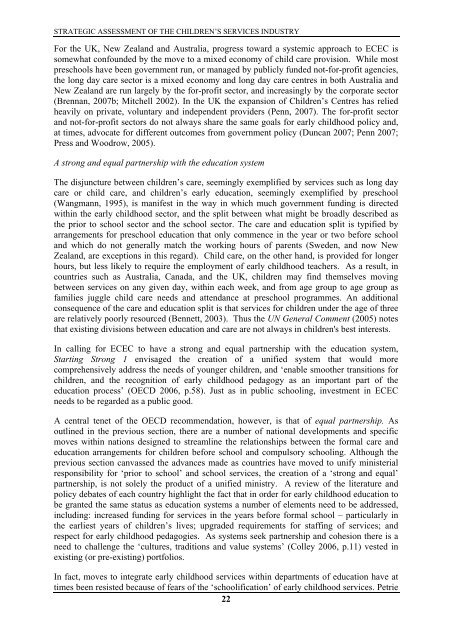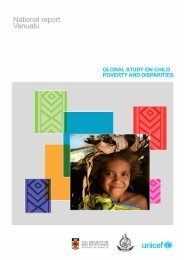A Strategic Assessment of the Children's Services Industry
A Strategic Assessment of the Children's Services Industry
A Strategic Assessment of the Children's Services Industry
- No tags were found...
Create successful ePaper yourself
Turn your PDF publications into a flip-book with our unique Google optimized e-Paper software.
STRATEGIC ASSESSMENT OF THE CHILDREN’S SERVICES INDUSTRYFor <strong>the</strong> UK, New Zealand and Australia, progress toward a systemic approach to ECEC issomewhat confounded by <strong>the</strong> move to a mixed economy <strong>of</strong> child care provision. While mostpreschools have been government run, or managed by publicly funded not-for-pr<strong>of</strong>it agencies,<strong>the</strong> long day care sector is a mixed economy and long day care centres in both Australia andNew Zealand are run largely by <strong>the</strong> for-pr<strong>of</strong>it sector, and increasingly by <strong>the</strong> corporate sector(Brennan, 2007b; Mitchell 2002). In <strong>the</strong> UK <strong>the</strong> expansion <strong>of</strong> Children’s Centres has reliedheavily on private, voluntary and independent providers (Penn, 2007). The for-pr<strong>of</strong>it sectorand not-for-pr<strong>of</strong>it sectors do not always share <strong>the</strong> same goals for early childhood policy and,at times, advocate for different outcomes from government policy (Duncan 2007; Penn 2007;Press and Woodrow, 2005).A strong and equal partnership with <strong>the</strong> education systemThe disjuncture between children’s care, seemingly exemplified by services such as long daycare or child care, and children’s early education, seemingly exemplified by preschool(Wangmann, 1995), is manifest in <strong>the</strong> way in which much government funding is directedwithin <strong>the</strong> early childhood sector, and <strong>the</strong> split between what might be broadly described as<strong>the</strong> prior to school sector and <strong>the</strong> school sector. The care and education split is typified byarrangements for preschool education that only commence in <strong>the</strong> year or two before schooland which do not generally match <strong>the</strong> working hours <strong>of</strong> parents (Sweden, and now NewZealand, are exceptions in this regard). Child care, on <strong>the</strong> o<strong>the</strong>r hand, is provided for longerhours, but less likely to require <strong>the</strong> employment <strong>of</strong> early childhood teachers. As a result, incountries such as Australia, Canada, and <strong>the</strong> UK, children may find <strong>the</strong>mselves movingbetween services on any given day, within each week, and from age group to age group asfamilies juggle child care needs and attendance at preschool programmes. An additionalconsequence <strong>of</strong> <strong>the</strong> care and education split is that services for children under <strong>the</strong> age <strong>of</strong> threeare relatively poorly resourced (Bennett, 2003). Thus <strong>the</strong> UN General Comment (2005) notesthat existing divisions between education and care are not always in children's best interests.In calling for ECEC to have a strong and equal partnership with <strong>the</strong> education system,Starting Strong 1 envisaged <strong>the</strong> creation <strong>of</strong> a unified system that would morecomprehensively address <strong>the</strong> needs <strong>of</strong> younger children, and ‘enable smoo<strong>the</strong>r transitions forchildren, and <strong>the</strong> recognition <strong>of</strong> early childhood pedagogy as an important part <strong>of</strong> <strong>the</strong>education process’ (OECD 2006, p.58). Just as in public schooling, investment in ECECneeds to be regarded as a public good.A central tenet <strong>of</strong> <strong>the</strong> OECD recommendation, however, is that <strong>of</strong> equal partnership. Asoutlined in <strong>the</strong> previous section, <strong>the</strong>re are a number <strong>of</strong> national developments and specificmoves within nations designed to streamline <strong>the</strong> relationships between <strong>the</strong> formal care andeducation arrangements for children before school and compulsory schooling. Although <strong>the</strong>previous section canvassed <strong>the</strong> advances made as countries have moved to unify ministerialresponsibility for ‘prior to school’ and school services, <strong>the</strong> creation <strong>of</strong> a ‘strong and equal’partnership, is not solely <strong>the</strong> product <strong>of</strong> a unified ministry. A review <strong>of</strong> <strong>the</strong> literature andpolicy debates <strong>of</strong> each country highlight <strong>the</strong> fact that in order for early childhood education tobe granted <strong>the</strong> same status as education systems a number <strong>of</strong> elements need to be addressed,including: increased funding for services in <strong>the</strong> years before formal school – particularly in<strong>the</strong> earliest years <strong>of</strong> children’s lives; upgraded requirements for staffing <strong>of</strong> services; andrespect for early childhood pedagogies. As systems seek partnership and cohesion <strong>the</strong>re is aneed to challenge <strong>the</strong> ‘cultures, traditions and value systems’ (Colley 2006, p.11) vested inexisting (or pre-existing) portfolios.In fact, moves to integrate early childhood services within departments <strong>of</strong> education have attimes been resisted because <strong>of</strong> fears <strong>of</strong> <strong>the</strong> ‘schoolification’ <strong>of</strong> early childhood services. Petrie22
















